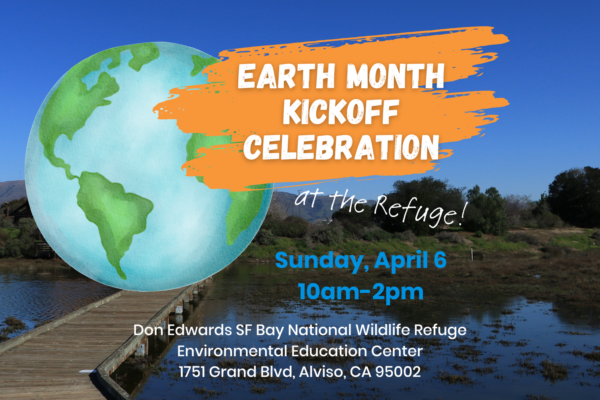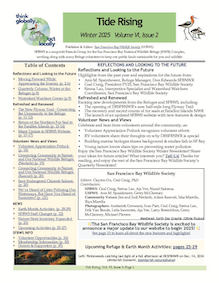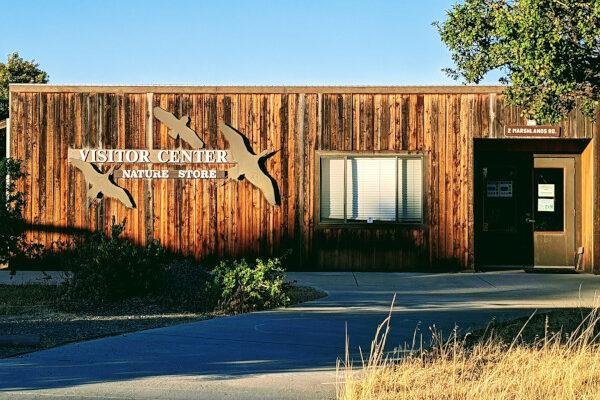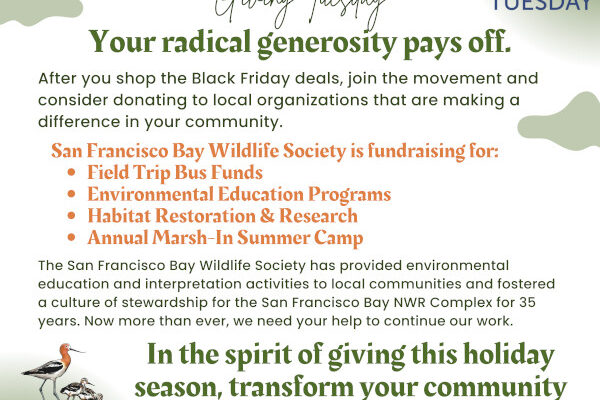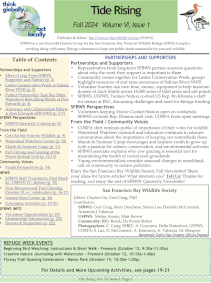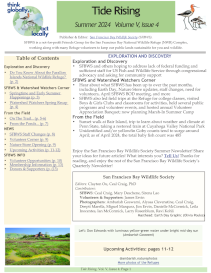-
Earth Month at the Refuge!
The San Francisco Bay Wildlife Society is excited to host an Earth Month Kickoff Celebration at the Refuge on Sunday, April 6th from 10am-2pm! The event will be an open house, with time to explore, join a guided…
Continue reading -
The Winter 2025 Issue of Tide Rising, our quarterly newsletter, is here
Tide Rising: Volume 6, Issue 2, Winter 2025. The San Francisco Bay Wildlife Society is pleased to publish the latest issue of its digital newsletter, Tide Rising: Volume 6, Issue 2,…
Continue reading -
Nature Store restocked at Don Edwards SFB NWR in Fremont
Visitor Center at the Don Edwards San…
Continue reading -
We’re Hiring: Wildlife Biology Associate
Updated January 17, 2025: This position is now filled. Thank you for your interest. POSITION Wildlife Biology Associate, San Francisco Bay Wildlife Society Duty Station – Don Edwards San Francisco Bay National Wildlife Refuge at 1 Marshlands Road, Fremont, CA. GENERAL DESCRIPTION San Francisco Bay Wildlife Society is recruiting for a part-time paid Associate…
Continue reading -
Support us with our membership drive this 2024 holiday season
Nature-themed Gifts This holiday season, share your love of nature and the National Wildlife Refuges by gifting your loved ones nature-themed gifts. You can buy the nature-themed gifts online or you can mail us a check along with an order form. ⇊…
Continue reading -
On #GivingTuesday 2024 help us conserve and preserve the essential wildlife habitat of the San Francisco Bay
San Francisco Bay Wildlife Society wants to wish you all happy holidays. No matter what holiday you may celebrate, as we all gather this season, we share the common values of gratitude, compassion, and giving. #GivingTuesday, the Tuesday after Thanksgiving, falling on December 3, 2024 this year, has become a…
Continue reading -
The Fall 2024 Issue of Tide Rising, our quarterly newsletter, is here
by Ceal Craig Tide Rising: Volume 6, Issue 1, Fall 2024. The San Francisco Bay Wildlife Society is happy to publish the latest issue of its digital newsletter, Tide Rising: Volume 6,…
Continue reading -
Celebrate National Wildlife Refuge Week 2024 (Oct 13-19) at Don Edwards SF Bay NWR
Come celebrate National Wildlife Refuge Week this year from October 13 through October 19 at the Don Edwards San Francisco Bay National Wildlife Refuge. This special week celebrates the important network of lands and waters that conserves and protects Americans’ precious wildlife heritage. Visit the Don Edwards San…
Continue reading -
Coastal Cleanup Day • September 22, 2024
Do you want to help wildlife and the environment? Join the thousands of people around the world for International Coastal Cleanup Day. It is an international day of action to protect our oceans, watersheds, and wildlife from trash and debris. This massive volunteering effort has an astounding impact on…
Continue reading -
The Summer 2024 Issue of Tide Rising, our quarterly newsletter, is here
by Ceal Craig Tide Rising: Volume 5, Issue 4, Summer 2024. The San Francisco Bay Wildlife Society is happy to publish the latest issue of its digital newsletter, Tide Rising: Volume 5,…
Continue reading


